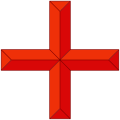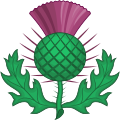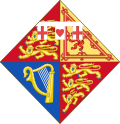| King George I to Queen Victoria |
| Name | Title | Royal Warrant | Label argent [2] [3]
 | Notes |
|---|
King George I
(1660–1727) | Electoral Prince of Hanover
British King from 1714. | As George was never a cadet member of the British royal family, he never had such a label. |
Ernest
(1674–1728) | Duke of York and Albany, Earl of Ulster | 1716 | 

 | 

 | 

 | Brother of George I.
Bishop of Osnabrück. |
George
(1683–1760) | Prince of Wales 1714 | | | | | Future King George II. |
Frederick
(1701–1751) | Duke of Gloucester 1718,
Duke of Edinburgh 1726 | | |  | | |
| Prince of Wales 1729 | | | | |
Anne
(1705–1759) | Princess Royal | 1719 |  |  |  |  |  | 2nd child, eldest daughter of George II.
Princess of Orange-Nassau. |
| 1727 |  |  |  |
Amelia
(1711–1786) | | 1719 |  |  |  |  |  | |
| 1727 |  |  |  |
| Caroline (1713–1757) | | 1719 |    |    |    |    |    | |
| 1727 | 

 | 

 | 

 |
William
(1721–1765) | | 1725 |  |  |  |  |  |
Duke of Cumberland
1726 | 1727 | |  | |
Mary
(1723–1772) | | 1727 |  |  |  |
Louise
(1724–1751) | | 1727 | 

 | 

 | 

 | Queen of Denmark and Norway |
Augusta
(1737–1813) | | 1813 |  |  |  |  |  | Duchess of Brunswick-Wolfenbüttel |
| George (1738–1830) | 2nd Duke of Edinburgh, Prince of Wales 1751 | | | | | Future king George III |
Edward
(1739–1767) | Duke of York and Albany 1760 | 1752 |  |  |  |  |  |
William (father)
(1743–1805) | Duke of Gloucester and Edinburgh 1764 | |  |  |  |  |  |
| Henry (1745–1790) | Duke of Cumberland and Strathearn 1766 | |  |  |  |  |  |
Frederick
(1750–1765) | | Posthumous |  |  |  |  |  |
George
(1762–1830) | Prince of Wales 1762 | | | | | Future King George IV |
Frederick
(1763–1827) | Duke of York and Albany 1784 | | |  | |
William
(1765–1837) | Duke of Clarence and St Andrews 1789 | 1781 |  |  |  | Future King William IV |
Charlotte
(1766–1828) | Princess Royal | |  |  |  | Queen of Württemberg |
Edward
(1767–1820) | Duke of Kent and Strathearn 1799 | |  |  |  | Father of Queen Victoria |
Augusta Sophia
(1768–1840) | | 1789 |  |  |  |
Elizabeth
(1770–1840) | | 1789 |  |  |  | Landgravine of Hesse-Homburg |
Ernest Augustus
(1771–1851) | Duke of Cumberland and Teviotdale 1799 | |  |  |  | King of Hanover 1837 |
Augustus Frederick
(1773–1843) | Duke of Sussex 1801 | |  | 
 |  |
Adolphus
(1774–1850) | Duke of Cambridge 1801 | | 
 |  | 
 |
Mary
(1776–1857) | | 1789 |  |  |  | Duchess of Gloucester and Edinburgh |
Sophia
(1777–1848) | | 1789 |  |  |  |
Amelia
(1783–1810) | | 1789 |  |  |  |
Leopold of Saxe-Coburg and Gotha
(1790–1865) | as consort of Princess Charlotte of Wales | | | |  | | | Later first King of the Belgians |
Charlotte of Wales
(1796–1817) | | 1816 | |  | |
| Queen Victoria to Queen Elizabeth II |
| Alexandrina Victoria of Kent (1819–1901) | | No known arms were assigned to her as Princess. | Future Queen Victoria |
| Albert of Saxe-Coburg and Gotha (1819–1861) | Prince Consort | 1837 | |  | | Husband of Queen Victoria. Quartered these arms with his paternal arms of Saxony. |
Victoria
(1840–1901) | Princess Royal | 1841 |  |  |  | German Empress |
Albert Edward
(1841–1910) | Prince of Wales | 1841 | | | | Future King Edward VII (1901) |
Alice
(1843–1878) | | 1858 |  |  |  | Grand Duchess of Hesse. |
Alfred
(1844–1900) | Duke of Edinburgh | ? |  |  |  | Duke of Saxe-Coburg and Gotha |
Helena
(1846–1923) | | 1858 |  |  |  | Princess of Schleswig-Holstein. |
Louise
(1848–1939) | | 1858 |  |  |  | Duchess of Argyll |
Arthur
(1850–1942) | Duke of Connaught
and Strathearn | 1874 |  |  |  |
Leopold
(1853–1884) | Duke of Albany 1881 | 1856 |  |  |  |
Beatrice
(1857–1944) | | 1858 |  |  |  | Princess of Battenberg. |
Albert Victor
(1864–1892) | Duke of Clarence and Avondale | 1890 | |  | | The firstborn son of Edward Prince of Wales, died in 1892. |
George
(1865–1936) | Duke of York | 1892 | |  | | Future King George V (1910) |
| Prince of Wales | 1901 | | | |
Louise
(1867–1931) | Princess Royal 1905 | 1889 |  |  |  |  |  | Duchess of Fife |
Victoria
(1868–1935) | | 1896 |  |  |  |  |  |
Maud of Wales
(1869–1938) | | 1896 |  |  |  |  |  | Queen of Norway |
Alfred of Edinburgh
(1874–1899) | | ? |  |  |  |  |  | Hereditary Prince of Saxe-Coburg and Gotha |
Marie of Edinburgh
(1875–1938) | | ? |  |  |  |  |  | Queen of Romania |
Victoria Melita of Edinburgh
(1876–1936) | | ? |  |  |  |  |  | Grand-duchess of Hesse, later Grand-duchess of Russia |
Alexandra of Edinburgh
(1878–1942) | | ? |  |  |  |  |  | Princess of Hohenlohe-Langenburg |
Margaret of Connaught
(1882–1920) | | 1905 |  |  |  |  |  | Crown princess of Sweden |
Arthur of Connaught
(1883–1938) | | 1904 |  |  |  |  |  |
Alice of Albany
(1883–1981) | | 1934 |  |  |  |  |  | Countess of Athlone |
Beatrice of Edinburgh
(1884–1966) | | ? |  |  |  |  |  | Duchess of Galliera |
Charles Edward of Albany
(1884–1954) | 2nd Duke of Albany | none | Duke of Saxe-Coburg and Gotha.
Deprived of his British titles 1919. Never granted arms in right of the United Kingdom, but used the arms of Dominion of Saxe-Coburg and Gotha as was his right as its sovereign. |
Patricia of Connaught
(1886–1974) | | 1919 |  |  |  |  |  | Lady Patricia Ramsay |
Edward
(1894–1972) | Prince of Wales | 1911 | | | | King Edward VIII, abdicated 1936 |
| Duke of Windsor | 1937 | |  | | Unique use of a Crown for an abdicated monarch. |
Albert
(1895–1952) | Duke of York 1920 | 1912 | |  | | Future King George VI (1936) |
Mary
(1897–1965) | Princess Royal 1932 | 1921 |  |  |  | Countess of Harewood |
Henry
(1900–1974) | Duke of Gloucester 1928 | 1921 |  |  |  |
George
(1902–1942) | Duke of Kent 1934 | 1921 |  |  |  |
Alastair of Connaught
(1914–1943) | 2nd Duke of Connaught
and Strathearn | 1942 | Quarterly 1 and 4 his grandfather's arms; 2 Fife; 3 Duff. |
| Queen Elizabeth II to King Charles III |
Philip
(1921–2021) | Duke of Edinburgh; Prince Consort | 1947–49: his arms included an inescutcheon of his ancestor Princess Alice (Grand Duchess of Hesse): the Royal Arms with a label as shown above. [4] |
Elizabeth
(1926–2022) | | 1944 |  |  |  | Future queen Elizabeth II (1952) |
Margaret
(1930–2002) | | 1944 |  |  |  | Countess of Snowdon |
Edward of Kent
(born 1935) | 2nd Duke of Kent | 1948 |  |  |  |  |  |
Alexandra of Kent
(born 1936) | | 1961 |  |  |  |  |  | Lady Ogilvy |
William of Gloucester
(1941–1972) | | 1962 |  |  |  |  |  |
Michael of Kent
(born 1942) | | 1962 |  |  |  |  |  |
Richard of Gloucester
(born 1944) | 2nd Duke of Gloucester | 1962 |  |  |  |  |  |
Charles
(born 1948) | Prince of Wales | 1958 | | | | Future king Charles III (2022) |
| Duke of Rothesay | 1974 | | | |
Anne
(born 1950) | Princess Royal | 1962 |  |  |  | Formerly Mrs Mark Phillips |
Andrew
(born 1960) | Duke of York | 1962/63 | |  | |
Edward
(born 1964) | | 1983 | |  | |
William
(born 1982) | Duke of Cambridge | 2000 | |  | | The escallop is taken from the arms of his mother Diana Spencer (1961–1997). |
| Prince of Wales | 2022 | | | | Succeeded his father to these titles in 2022. |
| Duke of Rothesay | 2022 | | | |
Harry
(born 1984) | Duke of Sussex | 2002 |  | |  | |  | The escallop is taken from the arms of his mother Diana Spencer (1961–1997). |
| Became a child of the Sovereign | 2022 |  |  |  | Changed to a three-point argent, each point charged with an escallop. |
Beatrice of York
(born 1988) | | 2006 |  | |  | |  | Bee from the arms of her mother. The three bees are a canting of her first name. |
Eugenie of York
(born 1990) | | 2008 |  | |  | |  | Thistles from the arms of her mother. |



































